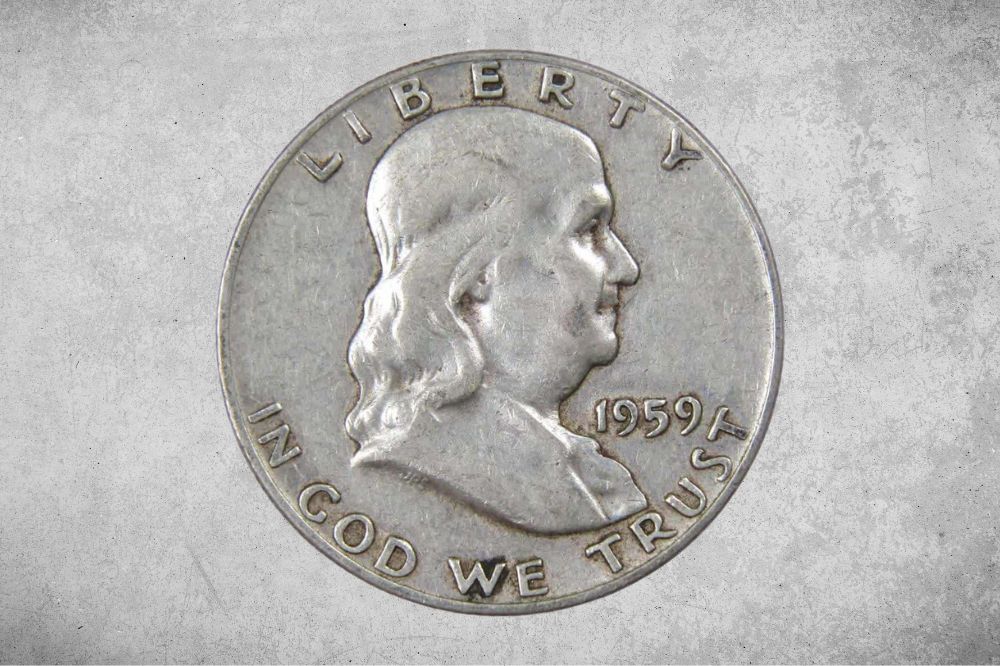The 1959 half dollar has an interesting history, and pristine versions of the coin are highly sought after by collectors and numismatists. If you have one of these coins, then you may well be wondering exactly how much it’s worth.
Here we’ll take a close look at the history of the coin, along with all of its variations. We’ll also give you all the information you need to know the value of the 1959 half dollar and if you’re sitting on a potential gold mine! Let’s start by looking at the specifics of this beautiful coin.
1959 Half Dollar Coin Details
- Type: Franklin Half Dollar
- Quantity Produced: 20,403,041
- Designer: John R. Sinnock/Gilroy Roberts
- Edge: Reeded
- Shape: Round
- Coin Diameter: 30.6mm
- Coin Thickness: 1.8mm
- Coin Weight: 12.5g
- Year of Minting: 1959
- Mint Mark: D/None
- Place of Minting: Philadelphia and Denver
- Face Value: $0.50
- $ price: $8 to $22,800
The 1959 Franklin half dollar is a fascinating coin that features a bust portrait of Benjamin Franklin on its obverse. This was an image created by John R. Sinnock, the chief sculptor-engraver of the Mint.
Prior to their original 1948 release, Nellie Tayloe Ross, the Mint’s director, proposed a coin that honored the former president. This was after she saw a U.S. Mint medal produced by Sinnock in Franklin’s honor back in 1933.
Back in the early 40s, Ross had opted to change the design of the coin when it became eligible for a replacement. However, the plans to update the coin had to be put on hold due to the huge production demands of World War II.
The Treasury announced the release of a new half dollar on January 7, 1948. At the time, they suggested that people use the Franklin coin wisely in tribute to Franklin, who was known to be a frugal man. The Treasury suggested that people use any spare cash to save money in savings stamps and savings bonds.
The portrait of Franklin was modeled after a bust by Jean-Antoine Houdon, an 18th-century sculptor. It was nicely done by Sinnock since the portrait came out clean and bold. However, he was not able to completely finish the designs as he died in 1947. His successor, Gilroy Roberts, finalized the design on the reverse side of the coin.
Above the portrait, which faces right, you will find “LIBERTY” inscribed above Franklin’s head. “IN GOD WE TRUST ” is below, while the date is to the right of Franklin. And if you look closely, “JRS” is tucked beneath the portrait’s shoulders.
On its reverse is the Liberty Bell, which is closely related to the life and death of Franklin. Not only is the Liberty Bell a symbol of the birth of the nation, but it’s also situated in Philadelphia, where Franklin lived and died.
It has three inscriptions around the bell, using the same sans-serif style found on its obverse. “HALF DOLLAR” is below, “UNITED STATES OF AMERICA” is above, then “E PLURIBUS UNUM” is written in smaller letters to the left.
To the right of the bell is an eagle, which was required by the law since 1792. The Coinage Act of 1873 reaffirmed this, which mandates that all U.S. silver coins bigger than a dime should display an eagle.
Also Read: Top 21 Most Valuable 2000 P Sacagawea Dollar Coin Worth Money
1959 Half Dollar Value Chart
| Coin Grade | Good | PR/MS63 | PR/M65 | PR/MS67 |
| 1959 Half Dollar | $9 | $30 | $150 | $5,000 |
| 1959-D Half Dollar | $9 | $30 | $150 | $5,000 |
| 1959 Proof Half Dollar | $10 | $12 | $100 | $6,000 |
1959 Half Dollar Value and Varieties Guides
The 1959 Franklin Half Dollar has three varieties, which include a proof version. Denver and Philadelphia were the only U.S. Mints that created the 1959 half dollars, with San Francisco stopping production of them in 1954.
One of the reasons that the value of these coins can get quite high is their scarcity. Even coins in bad condition can be sold far above face value, and there are a few reasons for this. The main reason is that they contain 90% silver.
Due to that high level of silver, these coins have often been sold in $50 face value bags as a means of trading precious metal. As it stands, the melt value of just one of these coins is around $8, so it’s clear to see why people were keen to sell or exchange them. As you can imagine, putting coins together in a bag is quickly going to damage their perfect appearance.
The other reason for the scarcity is that the U.S. Mint dropped its cardboard uncirculated set holders. Instead, the 1959 coins and later sets were housed in plastic. These didn’t preserve the coins quite as well or give the coins the desired coloration.
That leads us to today, where there are very few coins in perfect condition. With a mixture of general circulation, the high price of silver, and lower-quality coin holders, many people are prepared to pay a high price for perfect coins. Let’s take a closer look at the varieties.
1959 Half Dollar Coin
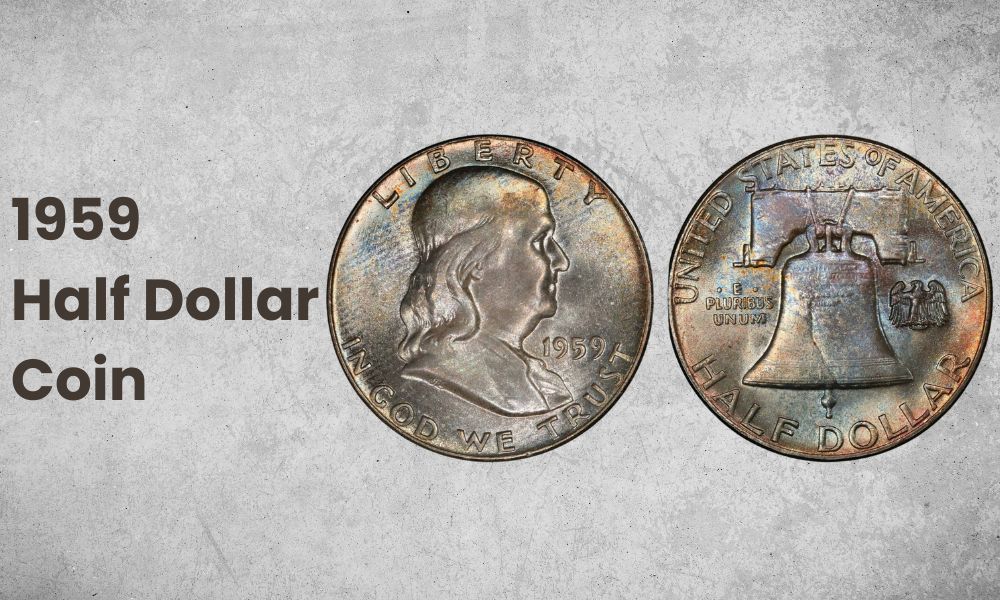
- Type: Franklin Half Dollar
- Edge: Reeded
- Mint Mark: None
- Place of Minting: Philadelphia
- Year of Minting: 1959
- Face Value: $0.50
- $ Price: $15 – $5,000
- Quantity Produced: 6,200,000
- Designer: John R. Sinnock
Philadelphia is one of the two mints to create the Franklin halves in the year 1959. You can determine these by lacking a mint mark on the coin. At that time, Philadelphia opted to skip using a mint mark to identify its production.
To confirm that you are looking at a Philadelphia variety, focus on the little area above the beam of the bell and below the “E” of “STATES. If the location of the mint mark is empty, that means Philadelphia struck that half dollar.
With over six million of them being struck in Philadelphia, they aren’t particularly rare, and it’s easy to find these coins for sale online. However, as we mentioned above, there is a scarcity of coins in perfect condition, and they can be quite valuable.
If you are unsure how grading works, then check out our quick guide below. For MS63 coins, you can expect to get around $30 for these as they are in mint condition but far from perfect. Most MS65 coins will sell for around $100, but fine examples can reach up to $400 at auction.
The high price of silver means that these coins should sell for at least $10, with those in good condition selling for approximately $15. When you get up to a mint state rating of 67, these coins can sell for thousands of dollars.
1959 D Half Dollar Coin
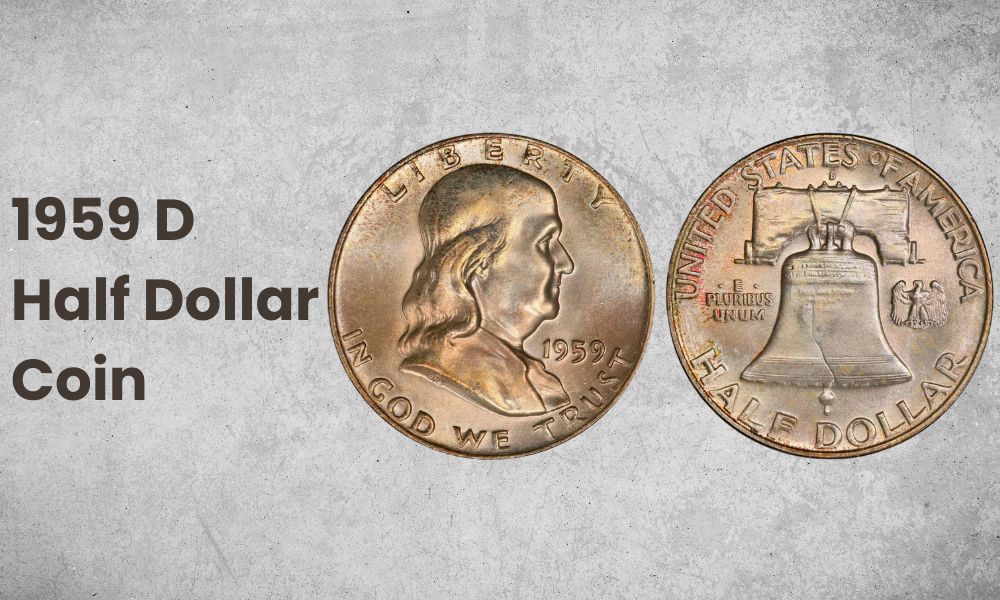
- Type: Franklin Half Dollar
- Edge: Reeded
- Mint Mark: D
- Place of Minting: Denver
- Year of Minting: 1959
- Face Value: $0.50
- $ Price: $8 – $5,000
- Quantity Produced: 13,053,750
- Designer: John R. Sinnock
Like other coins from the Franklin series, the D coin is a very common piece in good condition but continuously scarce above the grades MS65.
Denver issued half dollar coins identifiable by the “D” mint mark on its reverse. Looking at the top of the beam that suspends the Liberty bell, seeing a D confirms that Dever struck the coin.
Decades passed before collectors started becoming more aware of the quality of such coins. Plus, the MS examples you see today were traded by the bag from one group to another, making these heavily marked in the process.
Like all the other Franklins from 1953 to 1963, the coins lack the usual attractive toning. This effect usually comes from the U.S. Mint’s usage of plastic holders. This is another reason for the limited number of assigned high grades.
Around the end of 1950, the Denver Mint decreased its production to just around 13 million Franklin half dollars. Today, adequate supplies of these coins remain, with most valued at around $8 due to their silver content.
In terms of value, there is no notable difference between this and the no mark Philadelphia coin. They are both easily found today, and almost equally as rare. Most coins up to MS65 will sell for around $100, with some fetching more than that.
However, as with both coins, perfect versions (MS67) can sell for thousands of dollars. For a coin in this condition, you can expect at least $1,000, with many selling at auction for around $5,000. The record sale for a Franklin half dollar is $14,688.
1959 Proof Half Dollar Coin
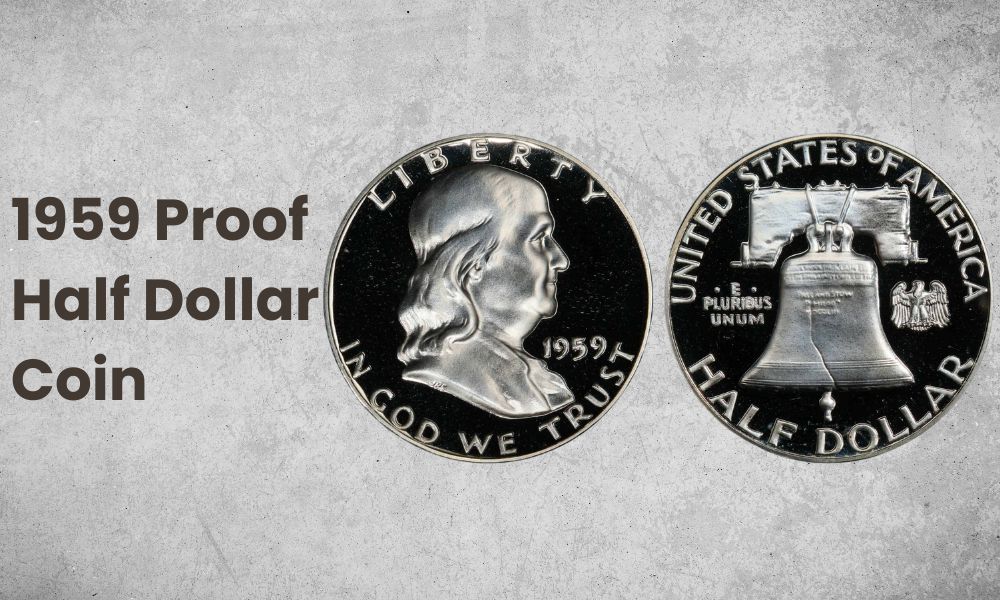
- Type: Franklin Half Dollar
- Edge: Reeded
- Mint Mark: None
- Place of Minting: Philadelphia
- Year of Minting: 1959
- Face Value: $0.50
- $ Price: $8 – $8,000
- Quantity Produced: 1,149,291
- Designer: John R. Sinnock
Along with the standard coins, there were also over a million proof coins released. These coins are generally not meant for circulation and instead are prized by collectors. These coins were made in Philadelphia and therefore have no mint mark.
As proof coins were never meant for circulation, they are expected to be in excellent condition. This is why for ratings around the 63 to 65 mark, you can expect regular circulated coins to sell more than proof coins.
There are many of these coins with a PR67 rating, and at auction, they have often been sold for around $6,000 to $8,000. However, the majority of PR67 coins sell for a more modest $400 to $600. A PR67 deep cameo coin was even sold for $22,800 back in 2020. However, most coins at this grade sell for much less than that.
With these coins, the date came well-struck, and tons of examples were preserved in excellent quality. It’s no surprise that some existing samples are even up to PR-69 condition. Generally, they are scarcer with Cameo surfaces, whereas Deep Cameo surfaces are even more scarce.
It’s incredibly rare to find any circulated coin above a 67 rating, but proof coins can often be even higher than that. These coins can vary a lot in price. Many have sold in the $500 to $700 region, but some fine examples have gone for over $8,000 at auction.
1959 Half Dollar History
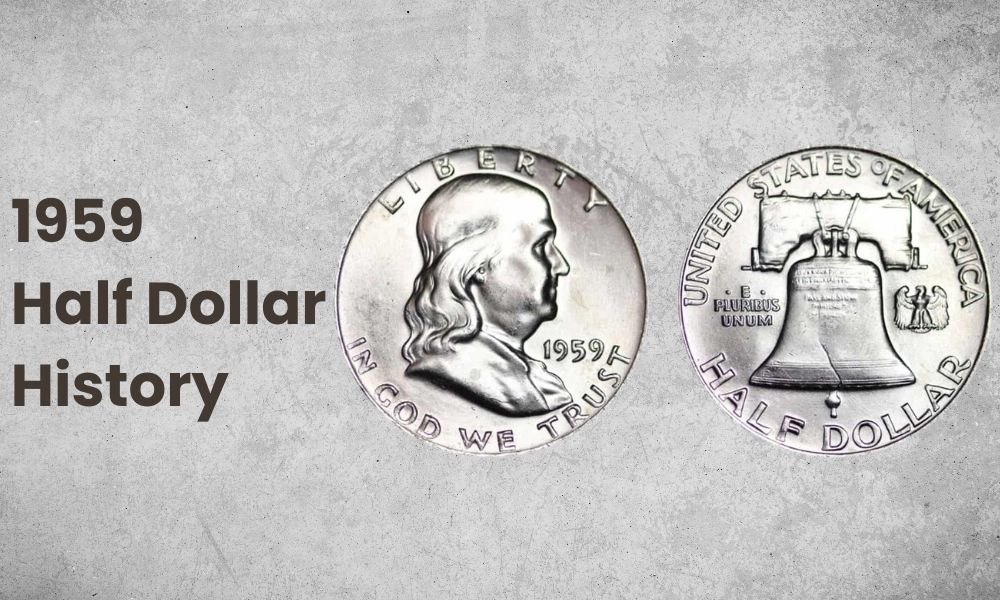
As mentioned earlier, Nellie Tayloe Ross was the person who proposed adding the late president to a coin. She was the Mint Director who greatly admired Benjamin Franklin and thought of adding him to a coin. These ideas started after seeing a medal designed by John Sinnock.
Ross knew Franklin disliked adding portraits on coins and preferred proverbs. However, she argued that the late president would not have issues including an image of a deceased U.S. founder on the coin.
In 1947, Ross requested Sinnock to design a half dollar featuring Franklin. To get the work started, Sinnock adapted his earlier works for the coin’s obverse. He designed it from a bust of the late president by Jean-Antoine Houdon.
Sinnock also based his creation for the reverse on the commemorative half dollar for the 150th anniversary of American Independence (1926).
Yet in May of the same year, Sinnock died even before completing the reverse design for the coin. Instead, the new chief engraver, Gilroy Roberts, completed the design to create the coin.
So on the 7th of January in 1949, the Treasury stated that a newly-designed half dollar would be released. This was also the time when they urged the people to use the Franklin coin as a reminder to save money and be thrifty.
Since John Sinnock was the designer of the half dollar, his initials (JS) were present on the coin. This was possible since the U.S. Mint lets artists add their initials to the coins they designed.
Technically, there shouldn’t be any issue with the initials. However, some conspiracy theorists claimed it referred to Joseph Stalin. So in response to such complaints and concerns, the Mint changed the initials JS to JRS. The JRS can be found on the 1959 coin, but unfortunately, doing so still didn’t stop the rumors.
In 1963, John F. Kennedy was assassinated, so congress proposed to include Kennedy’s image in the half dollar. With that came the end of the Franklin Half Dollar series on the 30th of December 1963.
1959 Half Dollar Grading
When collecting coins, these are graded based on their condition. The reason is that it’s an essential factor in determining the coin’s worth, and the deciding factor is the amount of wear.
Numismatists use the Sheldon Scale to give each 1959 Half Dollar a numerical value. This 70-point scale ranges from poor (P-1) to perfect mint state (MS-70). P-1 coins have a visible mint mark and date if they’re used, while MS-70 coins are flawless even under a microscope.
Proof coins use the same scale, but instead of using the words MS, PR is used instead.
List of 1959 Half Dollar Errors
In 1959, the U.S. Mint produced a total of 20,403,041 Franklin Half Dollar coins. It’s not surprising that some coins came with errors due to the high mintage. Here’s a list of the 1959 Half Dollar errors.
1. Doubled Die
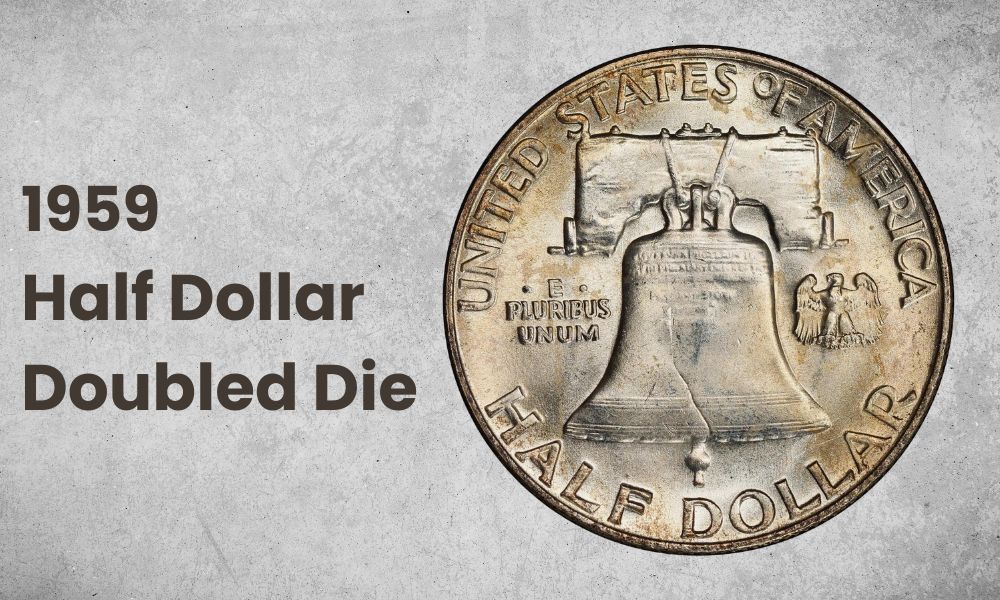
The doubled die error on the 1959 Half Dollar coin shows overlapping feathers on the eagle. On some coins, these overlap on the bell hanger, striker, and motto. You will even see the edges of the motto lettering dented at an angle.
In the 1960s, Frank Spadone called this variety “Medium Relief” before it was renamed as doubled die. 1959 Half Dollar coins with this error are scarce. In fact, the PCGS (Professional Coin Grading Service) has only identified 47 coins with this error.
2. Die Break Error
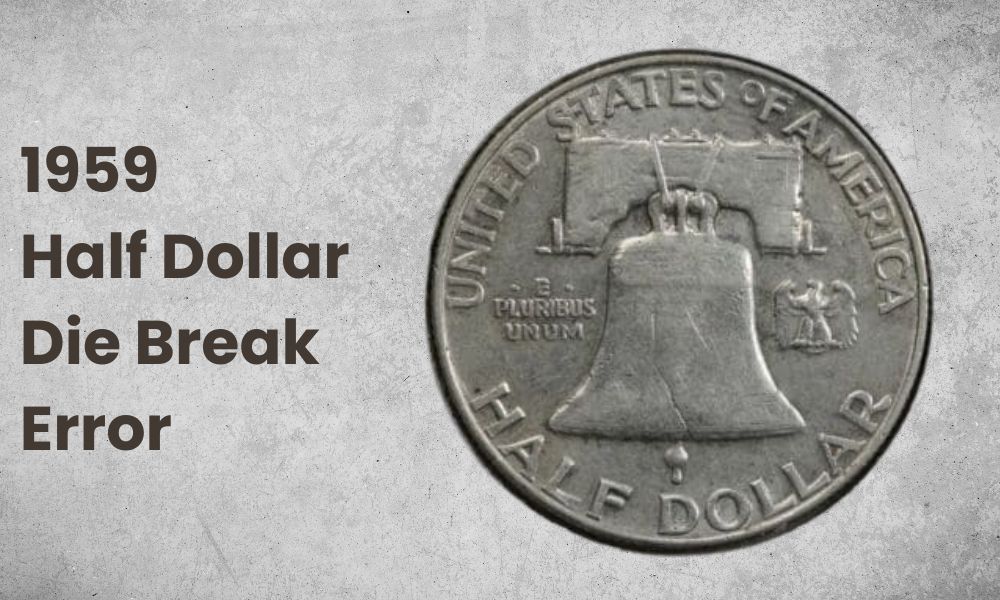
The die break error happens when the cracks of a broken die get imprinted on the coin. Wear and tear lead to the breaking of the die.
3. Bugs Bunny Half Dollar
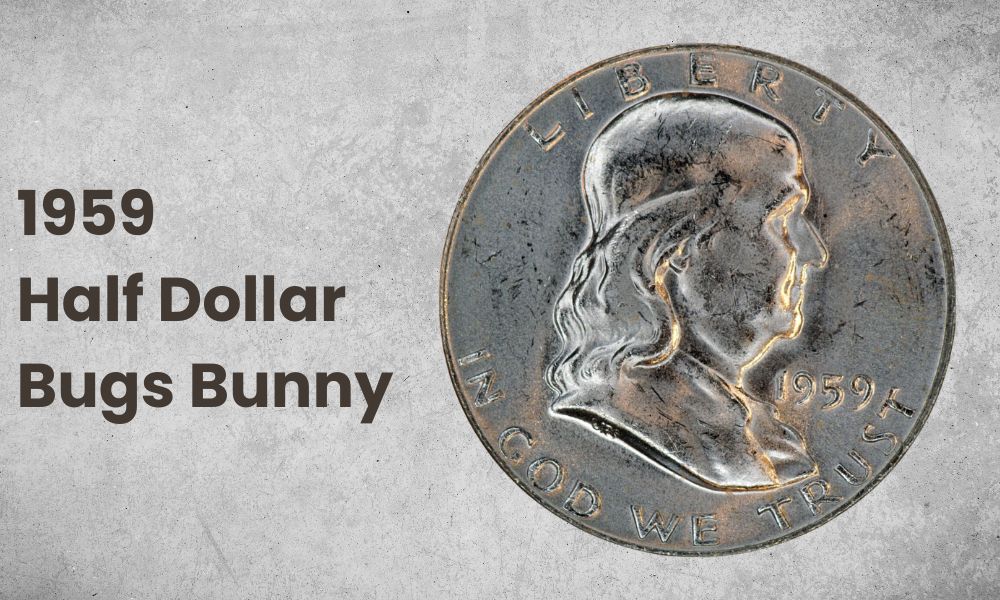
The Bugs Bunny Half Dollar is a popular error on the 1959 Half Dollar coin. A part of the eagle’s wings on the reverse die hit the obverse close to Franklin’s upper lip. As a result, the spike-shaped error that formed resembled a large buck tooth.
This error is called a die clash and is caused by the reverse and obverse dies coming together without a coin in between. When this happens, one of the dies may transfer a part of its design to the other.
FAQs
1. What is the rarest Franklin half dollar?
The 1950 MS 67+ FBL Franklin Half Dollar is the series’ highest-graded coin. Because of that, one collector paid a huge amount of $39,600 for one at a 2018 auction. The auction record for a 1959 half dollar was $22,800 for a deep cameo PR67 proof coin.
2. How do you tell if a half dollar is real silver?
The best way to tell if your half dollar coins are real silver is by viewing their edges. If the coin features a solid silver stripe, then you have one that’s real silver. If you notice a copper stripe, it means the coin is clad. For a coin with subdued silver stripes and light traces of copper, it means that your coin has 40% silver content.
3. Where is the mint mark on a 1959 Franklin half dollar?
Half dollars issued from Denver can be identified by a little “D” on its reverse. Specifically, it should be towards the top of the beam that suspends the Liberty Bell. Once you see a D mint mark, it confirms that Denver struck the coin. If you can’t find a mint mark, the coin was struck in Philadelphia.
